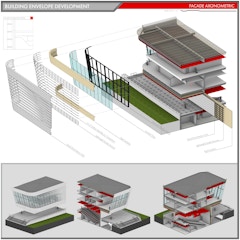
736 results
-
 Architects today must explore alternative enclosure materials to meet evolving energy codes and embodied carbon regulations. Terra cotta has been…
Architects today must explore alternative enclosure materials to meet evolving energy codes and embodied carbon regulations. Terra cotta has been… -

Lithic Revival
- Paper by Alex Terzich,
The recently completed Capital One Hall performing arts center located in the Washington DC metro area is defined by a pleated exterior of glass and… -

The Monash Woodside Building
- Paper by Alberto Sangiorgio · Andrew Cortese · Walter van der Linde
Today’s environmental challenges highlight the necessity of a holistic approach to façade design and construction, key to achieve the ambitious 2030
-

Simulation vs. reality: Measurement and verification
- Article by Stephen Montgomery · Lori O'Malley
This article explores the need for measurement and verification of building envelope and mechanical systems.
-

The Performative Double-Skin
- Paper by Jeffrey Abramson, AIA, LEED AP · Alejandra Menchaca, PhD, LEED AP, WELL AP
Double-Skin Facades (DSF) are well-known to boost the thermal performance of a façade: they can provide extra insulation in the wintertime and lower
-

City Development and Cladding Design
- Paper by Hadil Abdallah · Girma Bitsuamlak · Hamid Vossoughi, PE, P. ENG.
High-rise buildings in growing cities could become more vulnerable to variations in wind flow due to the continuous changes in urban topology. The
-

Modelling Perimeter Heating Demand
- Paper by Jonathan Graham · Geoffrey Turnbull, OAA, MRAIC, LEED AP, CPHD · David Constable OAA, LEED AP, CPHD · Mike Reimer P.Eng, LEED AP · Joshua Vanwyck, CPHD
Thermal discomfort can occur in perimeter zones due to radiant heat loss from the occupant to a poorly insulated exterior wall. It is valuable for
-

Energy conservation code updates promise to reshape the way facades are designed
- Article by Elliot Glassman
Ever-increasing performance requirements in the latest version of the energy codes are compelling project teams to consider the thermal performance of the building envelope more rigorously than ever before.
-

Catalytic Conversion
- Paper by Damon Caldwell
Nowadays, the power of images is seductive. Bold and complex facades often have an innovative appearance but superficial tectonic depth;
-

Digital Enablement for Manufacturing
- Paper by Melody Rees
Architectural design freedom achieved on high-end projects currently costs over $1,000/sq. Ft. Building materials have long been relegated to plane
-

Thermal bridging: The missing key to low energy building design
- Article by Ivan Lee
Thermal bridging through building facades have been overlooked or over-simplified by designers and building energy codes and standards in the past, which has led to higher space heating and cooling loads, occupant discomfort, and higher risk of condensation.
-

Structural Silicone Glazing
- Paper by Jon Kimberlain · Yvonne Diaz · Andrew Dunlap · Adrienne Bowman-Grittini
The recent 50 year anniversary of the first use of silicone sealant in a 4-sided structural silicone glazing application marks a sustainable and
-

Finally
- Paper by Michael Mulhern
For over 60 years architects, engineers, and consultants have been specifying stainless steels for use in building skins and in some structural
-

Design Principles For Museum Daylight Systems
- Paper by Edgar Stach, PhD · Michael Esposito
This research unlocks the relationship between space, structure and light in nine unique museums developed by architect Renzo Piano. Renzo Piano uses
-
Adaptive Reuse of Industrial Heritage Façades
- Paper by Bahar Basarir, PhD · Hatice Yasemin Cakir
With the developments in production, industrial facilities lost their function and were abandoned over time. The most frequent and often the most
-

Case Study: Kao Ho Hospital Development, Kaohsiung, Taiwan
- Paper by Jerry Ma · Jason JS Lin
U-shaped annealed profiled glass, or U channel glass is used in both the interior and exterior glass façade for decades, as it has long and durable
-

-

Simulation vs. reality: Insight and inspiration
- Article by Helen Sanders
Dr. Helen Sanders adds context to the Simulation vs. Reality dialogue.
-

Simulation vs. reality: FTI Forum recap
- Article by Stéphane Hoffman · Hamid Vossoughi
The Simulation vs. Reality Forum proved to be the most popular yet hosted by FTI, in person or virtual, emphasizing the importance and sensitivity of this topic in our professional work and its impact on the built environment.
-

ETFE Membrane Envelope Strategies
- Paper by Audrey L Worden, ISSF · Kihong R. Ku, DDes · Alexander G. Worden, RA NCARB
Airflow within the cavity of double-skin facades is a key component of adaptive building envelopes which change thermophysical properties to meet